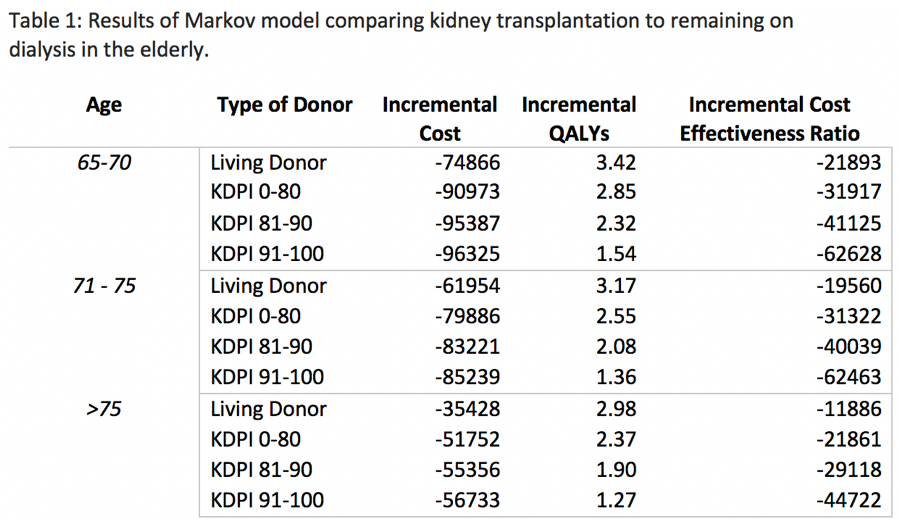Economic Evaluation of Kidney Transplantation in the Elderly Stratified by Donor Quality
1Nephrology, University of British Columbia, Vancouver, BC, Canada, 2Nephrology, University of Alberta, Edmonton, AB, Canada
Meeting: 2019 American Transplant Congress
Abstract number: D196
Keywords: Economics, Elderly patients, Kidney transplantation, Quality of life
Session Information
Session Name: Poster Session D: Non-Organ Specific: Economics & Ethics
Session Type: Poster Session
Date: Tuesday, June 4, 2019
Session Time: 6:00pm-7:00pm
 Presentation Time: 6:00pm-7:00pm
Presentation Time: 6:00pm-7:00pm
Location: Hall C & D
*Purpose: The cost-effectiveness of kidney transplantation in the elderly in recipients of a kidney with a high kidney donor profile index (KDPI) is unknown. In this analysis, we determined the cost-effectiveness of kidneys transplantation within strata of age groups and varying donor kidney quality in the elderly.
*Methods: Using the United States Renal Data System, we established a cohort of Medicare insured individuals aged 65 and older waitlist for transplantation from January 1st, 2000 and October 1st, 2016 (n = 39111). Gompertz models were used to estimate survival probabilities and corresponding health care costs were estimated using generalized linear models of actual Medicare payments from 2010 – 2014. All models were stratified by age (65-70, 71-75 and >75) and treatment modality (dialysis, living donor transplantation, and deceased donor transplantation stratified by KDPI), adjusting for known confounders. The probabilities and costs informed a Markov model to determine the incremental cost and effectiveness of kidney transplantation compared with remaining on dialysis from the health care payer perspective with a 20 year time horizon. Utility estimates in quality adjusted life years (QALYs) were obtained from existing literature.
*Results: In all age strata, regardless of the type of donor, kidney transplantation resulted in an increase in QALYs at a lower cost compared to remaining on dialysis (Table 1). The incremental effectiveness of transplantation was highest in recipients of a living donor transplant, and lowest in recipients of a deceased donor transplant with a KDPI 91-100%. These findings were robust in one-way sensitivity analyses and probabilistic analyses.
*Conclusions: Kidney transplantation in this model of wait-listed elderly patients with end-stage kidney disease increased quality adjusted life years and was cost savings regardless of the type of donor or age category. The largest potential benefit of kidney transplantation was demonstrated with living donor transplantation in this cohort.
To cite this abstract in AMA style:
Kadatz M, Klarenbach S, Gill JS, Gill J. Economic Evaluation of Kidney Transplantation in the Elderly Stratified by Donor Quality [abstract]. Am J Transplant. 2019; 19 (suppl 3). https://atcmeetingabstracts.com/abstract/economic-evaluation-of-kidney-transplantation-in-the-elderly-stratified-by-donor-quality/. Accessed December 9, 2025.« Back to 2019 American Transplant Congress

